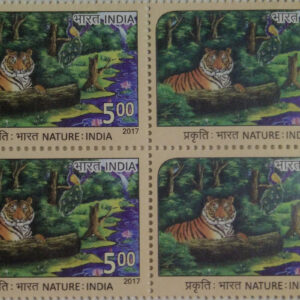The tiger is estimated to have been present in the Indian subcontinent since the Late Pleistocene, for about 12,000 to 16,500 years.[6][7][8] Today, it is threatened by poaching, loss and fragmentation of habitat, and was estimated at comprising fewer than 2,500 wild individuals by 2011. None of the Tiger Conservation Landscapes within its range is considered large enough to support an effective population of more than 250 adult individuals.[9]
The Bengal tiger’s historical range covered almost all of India and into Pakistan‘s Indus River valley until the early 19th century.[7] Today, it inhabits India, Bangladesh, Nepal, Bhutan and southern Tibet. India’s tiger population was estimated at 2,603–3,346 individuals by 2018.[10] Around 300–500 individuals are estimated in Bangladesh,[9] 220–274 in Nepal by 2018,[11] and 90 individuals in Bhutan by 2015
In the 20th century, Indian censuses of wild tigers relied on the individual identification of footprints known as pug marks – a method that has been criticised as deficient and inaccurate. Camera traps are now being used in many sites.[38]
Good tiger habitats in subtropical and temperate forests include the Tiger Conservation Units (TCUs) Manas–Namdapha. TCUs in tropical dry forest include Hazaribag Wildlife Sanctuary, Nagarjunsagar-Srisailam Tiger Reserve, Kanha–Indravati corridor, Orissa dry forests, Panna National Park, Melghat Tiger Reserve and Ratapani Tiger Reserve. The TCUs in tropical moist deciduous forest are probably some of the most productive habitats for tigers and their prey, and include Kaziranga–Meghalaya, Kanha–Pench, Simlipal and Indravati Tiger Reserves. The TCUs in tropical moist evergreen forests represent the less common tiger habitats, being largely limited to the upland areas and wetter parts of the Western Ghats, and include the tiger reserves of Periyar, Kalakad-Mundathurai, Bandipur and Parambikulam Wildlife Sanctuary.[36]
During a tiger census in 2008, camera trap and sign surveys using GIS were employed to estimate site-specific densities of tiger, co-predators and prey. Based on the result of these surveys, the total tiger population was estimated at 1,411 individuals ranging from 1,165 to 1,657 adult and sub-adult tigers of more than 1.5 years of age. Across India, six landscape complexes were surveyed that host tigers and have the potential to be connected. These landscapes comprise the following:[39]
- in the Sivaliks–Gangetic flood plain landscape there are six populations with an estimated population size of 259 to 335 individuals in an area of 5,080 km2 (1,960 sq mi) of forested habitats, which are located in Rajaji and Corbett National Parks, in the connected habitats of Dudhwa-Kheri–Pilibhit, in Suhelwa Tiger Reserve, in Sohagi Barwa Sanctuary and in Valmiki National Park;
- in the Central Indian highlands there are 17 populations with an estimated population size of 437 to 661 individuals in an area of 48,610 km2 (18,770 sq mi) of forested habitats, which are located in the landscapes of Kanha-Pench, Satpura–Melghat, Sanjay–Palamau, Navegaon-Indravati; isolated populations are supported in the tiger reserves of Bandhavgarh, Tadoba, Simlipal and the national parks of Panna, Ranthambore–Kuno–Palpur–Madhav and Saranda;
- in the Eastern Ghats landscape there is a single population with an estimated population size of 49 to 57 individuals in a 7,772 km2 (3,001 sq mi) habitat in three separate forest blocks located in the Srivenkateshwara National Park, Nagarjunasagar Tiger Reserve and the adjacent proposed Gundla Brahmeshwara National Park, and forest patches in the tehsils of Kanigiri, Badvel, Udayagiri and Giddalur;
- in the Western Ghats landscape there are seven populations with an estimated population size of 336 to 487 individuals in a forested area of 21,435 km2 (8,276 sq mi) in three major landscape units Periyar–Kalakad-Mundathurai, Bandipur–Parambikulam–Sathyamangalam–Mudumalai–Anamalai–Mukurthi and Anshi–Kudremukh–Dandeli;
- in the Brahmaputra flood plains and northeastern hills tigers live in an area of 4,230 km2 (1,630 sq mi) in several patchy and fragmented forests;
- in the Sundarbans National Park tigers live in about 1,586 km2 (612 sq mi) of mangrove forest.
Manas–Namdapha, Orang–Laokhowa and Kaziranga–Meghalaya are Tiger Conservation Units in northeastern India, stretching over at least 14,500 km2 (5,600 sq mi) across several protected areas.[36] Tigers are also present in Pakke Tiger Reserve.[40] In the Mishmi Hills, tigers were recorded in 2017 up to an elevation of 3,630 m (11,910 ft) in snow.[41] Ranthambore National Park hosts India’s westernmost tiger population.[42] The Dangs’ Forest in southeastern Gujarat is potential tiger habitat.[43]
As of 2014, the Indian tiger population was estimated to range over an area of 89,164 km2 (34,426 sq mi) and number 2,226 adult and subadult tigers older than one year. About 585 tigers were present in the Western Ghats, where Radhanagari and Sahyadri Tiger Reserves were newly established. The largest population resided in Corbett Tiger Reserve with about 215 tigers. The Central Indian tiger population is fragmented and depends on wildlife corridors that facilitate connectivity between protected areas.[44] By 2018, the population had increased to an estimated 2,603–3,346 individuals.[10]
In May 2018, a tiger was recorded in Sahyadri Tiger Reserve for the first time in eight years.[45] In February 2019, a tiger was sighted in Gujarat’s Lunavada area in Mahisagar district, and found dead shortly afterwards.[46] Officials assumed that it originated in Ratapani Tiger Reserve and travelled about 300 km (190 mi) over two years. It probably died of starvation. In May 2019, camera traps recorded tigers in Mhadei Wildlife Sanctuary and Bhagwan Mahaveer Sanctuary and Mollem National Park, the first records in Goa since 2013.[47][48]
The tigers in the Sundarbans in India and Bangladesh are the only ones in the world inhabiting mangrove forests.[43] The population in the Indian Sundarbans was estimated as 86-90 individuals in 2018.[















Reviews
There are no reviews yet.